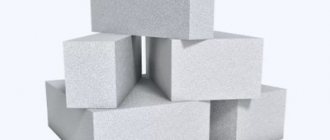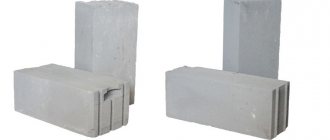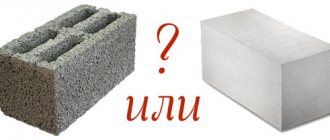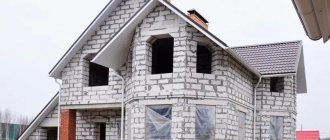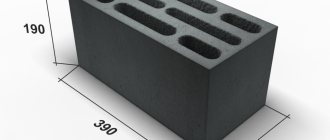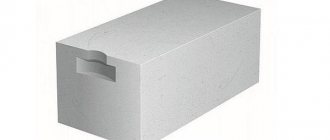This building material is relatively new, but due to its technical indicators and properties it has managed to gain popularity among consumers. Its use in the construction industry makes it possible to create good thermal and sound insulation conditions, and the variety of parameters and reasonable cost make foam block a convenient and affordable material.
Foam block - a type of cellular concrete
This is a porous building material, for the production of which cement material, sifted sand, clean water and a foaming agent are used. Foam block is a type of cellular concrete. In its structure, it resembles aerated concrete; void areas in it are formed not due to chemical processes occurring inside during hardening, but due to mixing of the concrete mass with pre-prepared foam.
The foaming agent used is organic or synthetic.
The first type is protein-based, its cost is higher. But, in certain proportions, being part of the foam block, it gives it strength and environmental safety. Synthetics will cost much less, but the production of foam concrete blocks in this case will have a fourth class of danger.
We found out what foam blocks are made from. Let's look at the methods of its production. There are only two of them:
- cutting a monolithic piece into stones of the required size;
- pouring the mass into molds with the required width, height and length.
To save raw materials and increase the density of foam blocks, ash, clay and other bulk materials with small fractions are added to the raw material mass during mixing. This makes it possible to save on the cement composition and entails thickening of the partitions between the pores in the foam block, thereby increasing its strength. In this case, the parameters of the void areas decrease, increasing the thermal conductivity of the material.
What is a foam block: main features of the material
Foam concrete is used to produce building modules called foam blocks. The mass that forms them is produced by foaming the concrete mixture. The production technology includes several stages:
• Portland cement, sand, water, and environmentally friendly fiber are used for the mixture. All elements are mixed in a concrete mixer equipped with inclined blades.
• A foaming agent is added to the initial mixture, for which various additives are used. Mix the ingredients again.
• The finished mass is poured into a kind of mold formed by the formwork and left to dry naturally. The removable formwork is dismantled at the end of the technological process.
Various substances can act as a foaming agent, for example, saponified wood resin. In this case, large pores are formed.
Foam concrete is often prepared on a construction site due to the simplicity of the technology. However, under such conditions it is difficult to achieve high quality material, because its density will be uneven. In artisanal production, air bubbles inside the mixture move chaotically. Therefore, porosity differs within the same batch and even within the same block. But the price of such material is lower due to reduced production costs. This must also be remembered when deciding which is better - aerated concrete or foam concrete.
The main advantages of the material are:
• relatively light weight, which reduces the load on the foundation and reduces the cost of its arrangement;
• low thermal conductivity – a wall made of standard foam blocks retains heat in the same way as a classic partition made of 0.8 m thick brick;
• sufficiently high strength - it largely depends on the density of the block, and in any case will be lower than that of brick, but higher than that of timber, so that, subject to additional reinforcement, buildings up to three floors high can be erected from foam blocks;
• moisture resistance – the foam block is characterized by closed pores, it is a non-hygroscopic material. If it gets into water, it may not absorb liquid for several days,
• fire safety - this material does not support combustion, and since it consists of environmentally friendly components, no toxic substances are released from it even under the influence of flame;
• frost resistance – foam blocks retain their strength and other listed properties even when exposed to low temperatures.
When considering aerated concrete and foam concrete, the advantages and disadvantages of materials, most attention is paid to thermal insulation characteristics and density. The disadvantage of foam blocks is the non-uniform density, as well as problems with the geometry of the block. In construction site conditions, it is difficult to achieve accurate dimensions. This may lead to increased installation costs in the future.
Specifications
We figured out what a foam block is. Now let's look at its performance. The main characteristics of the foam block are:
- Density is a quantity represented by the ratio of the weight of a material to its volume. It is designated by the letter “D” with numbers from 400 to 1,200. The strength of the foam block depends on this indicator;
- the weight of the foam block - its dependence is determined by the density at a normal level of humidity. Weight can vary between 8.5 – 47 kg. Having clarified this indicator, it becomes possible to determine the mass of one cubic meter of material;
- resistance to low temperatures - measured by the number of “freezing-thawing” cycles, has different values. Blocks with the highest rating are used in the construction of facilities beyond the Arctic Circle;
- foam block parameters are determined by GOST. For an external wall - 20 x 40 cm, for an internal type load-bearing wall - 30 x 20, for a partition - 10 x 30. Moreover, the length of the foam blocks of each group is the same and is 60 cm.
Requirements for foam block
According to GOST 31360-2007 and GOST 31359, several important requirements are imposed on the foam block:
- Thermal conductivity. For brand D500 no more than 0.12 W * m C;
- Deviations of geometric dimensions. No more than 1/2-3-4 mm;
- Compressive strength. Not less than B1.5;
- Specific effective activity of radionuclides. No more than 370 Bq/kg;
- Vapor permeability. For grade D500 no less than 0.20 μ, mg/(m h Pa);
- Frost resistance. For internal not less than F15, for external - not less than F
The gas block can be light gray, but not white
Advantages and disadvantages
Foam block is a material characterized by its positive and negative aspects.
It is believed that the block gains strength with use. If we compare a new stone and one that has served for five decades, the density of the latter will be three times higher.
The block has earned popularity due to the following qualities:
- compressive strength - determined by the volumetric mass of the foam used for the blocks and other additives. This indicator is influenced by the moisture level of the material;
- density - depends on the brand of cement;
- weight of the foam block - due to the porosity filled with air, the block does not weigh very much. This makes it possible to save money when arranging the foundation base, and facilitates the construction process, since masonry work can be done with your own hands, without involving additional labor and special equipment;
- low thermal conductivity - the air in the pores helps retain heat inside the room. This makes it possible to optimize the thickness of the walls, reduces the pressure on the foundation, and reduces the cost of installing an insulating layer. As follows from the manufacturer’s calculations, heat losses with such walls are reduced by thirty percent;
- sound insulation of foam concrete blocks - the pores absorb extraneous noise, especially low-frequency ones;
- fire resistance of foam concrete blocks - the material meets all the requirements for fire safety of the facility;
- environmentally friendly - as follows from numerous reviews, the foam block does not rot and does not cause harm to the human body. For its production, a foaming agent is used that does not emit hazardous gases;
- reasonable cost – makes it possible to minimize construction costs;
- ease of work – installation of foam blocks is carried out quickly, since the material is voluminous, but does not weigh very much, and can be easily processed with hand tools;
- geometric parameters of the object - construction from foam blocks is convenient in that the house can be set in advance with the necessary parameters. And the main advantage in this is given to the exact sizes of the stones;
- low consumption of adhesive mixture for foam blocks during construction work;
- resistance to high levels of humidity. The material almost does not absorb water, and if it is placed in a container filled with liquid, it will remain on the surface;
- resistance to frost - changes in temperature conditions do not affect the service life of the foam block;
- it is possible to combine foam block stone with other building materials.
If you weigh the pros and cons of the foam block, then you should consider its negative sides:
- low bending strength - the material is inferior in this value to concrete and reinforced concrete analogues. But if you increase the grade of foam concrete, you can achieve a better strength value, while losing a certain value of thermal insulation properties;
- heterogeneity of porous areas - a foam block with “holes” inside does not hold various decorative elements and heavy objects on its surface well, the fixation of which requires special fasteners;
- deviations from the density indicator may be observed. This is due to the peculiarities of production - violation of the proportions of components or poor mixing;
- the process of natural shrinkage - it is recommended to start finishing only a couple of months after the completion of the walls, since shrinkage can range from 2 to 4 mm per linear meter.
The foam block needs four weeks to dry completely. During this period, it gains full strength.
Production technology
The production technology consists of a special solution, which, after mixing, is formed into blocks. Foam concrete is a mixture of sand, cement, and water. Nothing new. But this new thing lies in the technology for preparing the solution itself. It is not poured into molds immediately after mixing, but placed in a special pressure mixer, in which the solution is whipped until foamy. To quickly obtain a high-quality foamy mass, rosin and bone glue are used. Then, to improve the structure, polymers are added, which serve as reinforcement and maintain the porosity of the foam blocks, which increases their strength. Another component of the foam block is small particles of combustion products, which increase the density of the foam block and, at the same time, allow saving up to 30% of cement.
Now it’s worth saying a few words about the private production of foam concrete in order to make the right choice when purchasing. The technology for making foam blocks is no secret, equipment can also be purchased, so entrepreneurs do not miss this opportunity to make money. But, as you know, private production is always less profitable than industrial scale. To reduce the cost of producing foam blocks and get higher profits, private manufacturers sometimes resort to tricks, using cheaper additives, which worsens the quality of the product. Therefore, having set the goal of purchasing a foam block, you need to inquire about the quality certificate of the product, which should be available to every self-respecting seller.
Foam blocks and gas blocks are very difficult to distinguish visually
Production Features
When choosing building materials, especially such as cellular concrete, you need to pay attention to even the smallest details. Because they are the ones who ultimately influence how warm and durable the structure will be. We will describe these subtleties in this section.
Foam concrete has a more uniform structure
- Production technology.
- Making foam concrete is so simple that it can be done in the garage. It is enough to buy a foaming agent, and the remaining components are easily available. The mixture (cement+sand+water) is mixed in any container, a foaming additive is added. Next, the composition is poured into molds. The ripening of the blocks occurs under natural conditions - in the air. That is, you can do without special equipment, quality control is conditional - you need to adhere to known proportions and technology. But you really want to save money... That’s why there are a large number of foam blocks on the market, the quality of which is far from GOST standards.
- Aerated concrete is just as easy to mix, but there are two types - autoclaved and non-autoclaved. Non-autoclave also dries in the open air, but does not have the best characteristics. Autoclaved aerated concrete undergoes a hardening process at elevated pressure and temperature. As a result, the blocks are of increased strength. They cost more, but are also much stronger.
- Accuracy of geometric dimensions.
- Aerated concrete blocks are produced in two ways. According to one technology, the composition is poured into ready-made molds. These blocks have a difference in size of up to 3-5 mm. Using another technology, large-format blocks are formed, which are then cut to specified sizes. The difference in size of such material is minimal. Strength of foam concrete of different densities
- Foam concrete is poured into ready-made forms. There is no other technology. Accordingly, the difference in block geometry can be significant. It is corrected by increasing the masonry seam, which reduces the thermal insulation characteristics of the masonry as a whole. So when choosing, focus on geometry. If the blocks are almost identical (GOST allows deviations of 1 mm), there is hope that the technology was followed.
If we consider these materials from this point of view, then autoclaved aerated concrete with minimal differences in dimensions is more preferable. Masonry from this material is made using special glue. It is applied in a layer of a couple of millimeters, since the ideal geometry allows this to be done. Since the seam on a wall made of this material is a bridge of cold, the wall turns out to be very warm (due to the small thickness of the seam, heat is better retained in the building).
When using foam blocks with a large discrepancy in size, a regular mortar is used for masonry. The glue is too expensive to apply in large layers. When using cement mortar, the costs are much lower, but the thermal insulation characteristics of the building cannot be compared - they are much lower.
Construction from foam blocks
Having decided to use this material, you need to choose it correctly. Experienced experts recommend paying attention to certain factors:
- manufacturer - it is best to contact large factories, whose administration will not risk its reputation and will provide the units with the appropriate accompanying documents confirming their quality;
- price - if the cost of the material is lower than the market price, then it is likely that violations were committed during manufacturing. Discounts can only be arranged taking into account the purchased batch, the proximity of the construction site, and the type of material;
- storage conditions and packaging material - in order not to purchase blocks that have absorbed moisture, you need to know how to store foam blocks outdoors. It is best to do this under shelters and use polyethylene material as packaging.
In order for the object you built to serve for a long time, it is recommended to study the basic rules of working with the material, which include one feature - cement-based mortar is not used for foam blocks in order to avoid the formation of a “cold bridge”.
What is more profitable to use - aerated concrete or foam concrete?
All cellular concrete is considered a more cost-effective option compared to brick. Foam concrete is cheaper, but this does not mean that, other things being equal, it will be possible to save on construction.
You need to draw up a preliminary estimate and go through all the points. For example, laying gas blocks requires expensive special glue. But the thickness of the seam is minimal, so its consumption will be small. For foam blocks, a cheaper cement-sand mixture is used, but in order to avoid cold bridges, it is better to take a material with increased thermal insulation characteristics, but it itself is more expensive. Due to the uneven surface of the blocks, the consumption will be high, so there will not be much savings. The only drawback of glue is that it requires certain working skills. The cement-sand mixture is easy to work with. If you hire builders, they will handle the glue. But it will be easier for novice craftsmen to work with foam blocks and mixtures.
Comparison of foam concrete and aerated concrete
| Characteristic | Aerated concrete | Foam concrete |
| Coefficient of thermal conductivity | 0,084-0,147 | 0,22-0,37 |
| Brands by density | 300, 400, 500, | 600, 700, 800, 900 |
| Strength | Class B2.5 at D400 | Class B2.5 at D700-800 |
| Vapor permeability | Aerated concrete is higher than foam concrete at the same density | |
| Deviations of geometric dimensions | +/- 1 mm | Up to 30 mm |
| Masonry, seam thickness | Laying with glue. Seam 1-3 mm | For sand-cement mortar. Seam up to 16mm |
| Foundation | Foam concrete has a higher specific gravity, therefore, with the same strength, the load on the foundation of foam concrete is higher | |
| Installation | Because foam concrete blocks are heavier, making it more difficult to carry out work on the construction of walls and their further finishing | |
| Working with material | Foam concrete blocks are more dense and uneven in structure, so they are more difficult to saw | |
| Durability | More than 100 years | About 50 years |
Moreover, foam concrete necessarily needs additional reinforcement. It is necessary even when constructing small buildings such as a bathhouse or outbuilding. This also increases construction costs.
Aerated concrete does not require additional leveling. Foam concrete needs to be plastered at a minimum - and here the costs increase again. Therefore, material that is cheaper at first glance will actually end up giving a higher amount in the estimate. Aerated concrete is a more profitable option - from the point of view of both technical and economic characteristics.
Types of material
Let's figure out what types of foam blocks there are:
- The types of lightweight foam blocks are determined by their density. The material is divided into three groups - thermal insulation, structural and thermal insulation, structural;
- according to the technological features of production - building foam blocks are cut, molded and reinforced;
- According to its intended purpose, the material can be wall, partition and non-standard, made to order. In addition, a foam block with foam chips inside is produced, which retains heat well inside the structure. An example of application is a basement made of such foam blocks.
How foam block is made
Production of foam blocks
Today, three technologies for the production of foam blocks are most widely used. This:
- Classical
The essence is the forced supply of an aero component into a pre-prepared sand-cement mixture. Blocks prepared using this technology are considered the best, and their characteristics are always ahead of those produced by other methods.
- Dry mineralization method
The foam component is added to the prepared but still completely dry mixture of ingredients. The suspension is mixed and only then water is added to it. This method is used in mass production, where the technological process is continuous.
- Using barotechnology
The subtleties of the technology are already hidden in its name. The main part of the process, namely mixing the components of the mixture with a foaming agent diluted with water, occurs in a special chamber at high pressure.
Reviews about foam blocks
As follows from numerous and varied statements, the material is indeed considered popular. It is used to construct premises and structures for various purposes:
- bathrooms made of foam blocks;
- bathrooms made of foam blocks;
- outbuildings;
- inspection pits made of foam blocks.
Consumer reviews indicate that high-rise buildings made of foam blocks with a monolithic frame are rapidly gaining popularity. This is confirmed by the fact that construction from foam blocks continues to gain momentum.
When choosing a material, you must carefully check it for cracks or oily stains. Such signs will indicate the poor quality of the stones.
The technology of construction from foam blocks has its own characteristics, with the help of which you can hide the imperfections of the stone by combining materials. An excellent solution is brick, from which load-bearing walls are laid, evenly distributing the load. Walls made of foam blocks are often paired with wood material.
To minimize the appearance of cracks, you should carefully consider the arrangement of the foundation base. It is better if it is monolithic. In addition, additional reinforcement is used for the walls in increments of three rows of masonry.
You can learn a lot of useful information from useful tips from experienced craftsmen and consumer reviews:
- how to waterproof foam blocks;
- rules for laying foam blocks on polyurethane foam;
- what load can foam blocks withstand;
- which foam block is considered the lightest;
- how to treat foam blocks so that they do not absorb moisture;
- how to correctly insert a window or door into a foam block wall;
- how to waterproof foam blocks in the bathroom;
- find out what the difference is between foam block and foam concrete;
- which foam blocks are best used in the construction of a particular facility;
- clarify the properties of foam blocks.
In addition, on the Internet there is information about the procedure for using foam blocks, the brand of foam blocks, and the shelf life of foam blocks.
If we build from foam blocks, then it is recommended to know the “weaknesses” of the material:
- violations of the technological process of masonry entail an increase in the fragility of the material;
- an object built from such stone needs an outer finishing layer to protect it from moisture;
- building multi-storey buildings from foam concrete is permitted only in compliance with the rules for masonry reinforcement.
- the shade of the material indicates strength: yellow indicates an excess amount of sand, grayish confirms the quality of the raw material;
- Delivery of block material stacked on pallets to the site will complicate unloading. You will have to hire special equipment;
- Check with the manufacturer how the unit was stored. It is not recommended to use material that has been exposed to the open sky;
- check the geometry of the stone and the presence of chipped areas.
Foam concrete blocks - an alternative and competitor to brick?
Content
Among building materials for the construction of walls of residential buildings, industrial premises and all kinds of outbuildings, foam concrete blocks firmly occupy one of the leading places.
They retain heat well, have a low specific gravity and are much cheaper than brick. Let us add that construction using this material is much faster. Another argument in favor of foam blocks is the possibility of their production directly on the construction site.
Foam blocks in construction
Application area
Finally, I’ll briefly tell you in what cases foam blocks can be used, and in what cases they should be abandoned.
Foam concrete block is an excellent material for building a bathhouse
So, blocks can be used for the following purposes:
- For the construction of private houses and outbuildings . Due to their low thermal conductivity, the blocks are excellent for private houses, the construction of bathhouses, garages, etc. The only thing, as I already said, the number of floors should be no more than three;
Thin blocks allow you to quickly erect lightweight interior partitions
- For the construction of partitions. There are thin blocks on sale that are designed specifically for the construction of interior partitions;
- For fencing walls of frame apartment buildings. Due to its light weight and low thermal conductivity, gas block is used in most new buildings.
It is not recommended to use foam blocks for foundations due to strong shrinkage, low load-bearing capacity and strong moisture permeability.

